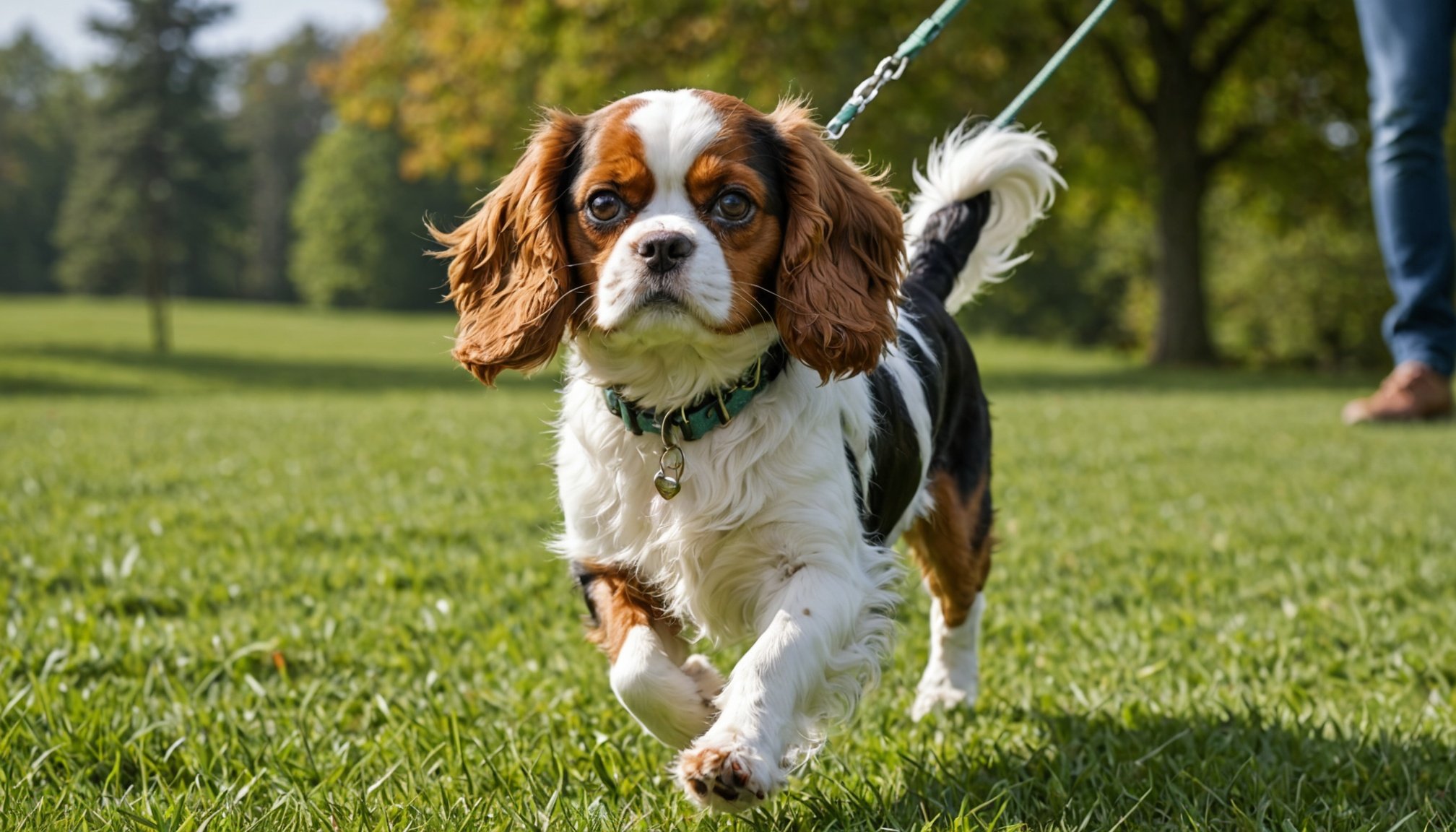Understanding Cavalier King Charles Spaniels
Cavalier King Charles Spaniels are known for their gentle and affectionate demeanor. This breed generally exhibits a loyal, friendly, and sociable nature, making them an excellent choice for families. Notably, they possess a keen ability to form strong bonds with their owners, often desiring companionship, snuggles, and attention.
Breed Behavior
The Cavalier King Charles Spaniel’s characteristics highlight their playful disposition. Despite their charming temperament, some Cavaliers may display walking issues due to a penchant for distraction. This curiosity can lead them to dally on walks, urging owners to maintain patience and remain consistent in training.
Sujet a lire : Effective strategies to curb separation anxiety in your border collie puppy: a comprehensive guide
Training Needs
Understanding a Cavalier King Charles Spaniel’s individual needs is crucial for implementing effective training techniques. Tailoring the approach to each dog’s personality can significantly enhance results. Positive reinforcement methods work well, considering their responsive nature. Practising consistent commands and rewarding them with treats encourages desired behaviors.
Importance of Recognizing Signals
For owners, recognizing subtle cues can prevent minor behavioral issues from escalating. Regularly assessing their unique needs fosters an environment of mutual understanding. Loneliness may manifest in destructive behavior, so ensuring plenty of interaction is essential. Ultimately, having knowledge of Cavalier King Charles Spaniel characteristics enriches the training experience, resulting in a happier, well-rounded pet.
A lire aussi : Mastering housebreaking: effective techniques for training your stubborn basset hound
Choosing the Right Equipment for Leash Training
When leash training your Cavalier King Charles Spaniel, having the right equipment is key. Selecting the best leash and collar can significantly affect the training process, ensuring comfort and safety for your pet while maintaining control.
Types of Leashes
Choosing the appropriate leash is essential. Standard nylon or leather leashes are sturdy and reliable for daily use. Retractable leashes offer flexibility, allowing your dog more freedom to explore while keeping boundaries. However, these may not be ideal for initial leash training due to less control. Instead, opt for a standard leash that provides more consistent guidance and helps establish good walking habits early on.
Selecting the Right Collar
When selecting a collar for a Cavalier King Charles Spaniel, prioritize comfort and fit. A soft, padded collar can prevent irritation and is preferred over rigid materials. Adjustable collars ensure a snug, yet comfortable fit that won’t damage the dog’s coat or skin. Martingale collars offer a humane option for dogs prone to slipping out of traditional collars, providing gentle control without choking.
Importance of Safety Gear
Incorporating safety gear like harnesses offers additional control, especially for small breeds like Cavaliers. A harness distributes pressure across the dog’s body, reducing neck strain. Safety reflectors or lights enhance visibility during low-light walks, ensuring both you and your pet can be seen clearly by others.
Training Techniques for Leash Walking
To ensure successful leash training, it’s essential to adopt a step-by-step approach. Start by letting your Cavalier get used to wearing a collar and leash indoors. Avoid pulling on the leash; instead, encourage your dog to walk beside you with gentle cues.
Positive reinforcement plays a critical role in this process. Every time your dog follows a cue or walks calmly, reward them immediately with treats or verbal praise. Consistent rewards make your dog associate good behaviour with pleasant outcomes, reinforcing the desired actions.
Teaching essential obedience commands is another cornerstone of effective leash training. Commands like “sit,” “stay,” and “heel” help establish clear communication. Begin with one command at a time, ensuring your Cavalier understands it fully before moving on to the next. Practicing these commands during walks enhances your dog’s focus and control.
- Supportive tips:
- Use high-value treats specifically for training sessions.
- Maintain short, focused training periods to keep your dog engaged.
- Be patient and persistent, as consistency is key for lasting results.
By following these structured leash training techniques and using positive reinforcement, your Cavalier will learn to enjoy their walks with you, making outings a pleasant experience for both.
Common Challenges in Leash Training
Leash training can present several challenges for dog owners. These challenges, while common, can be addressed with patience and the right training solutions.
Pulling and Lunging
Dogs often pull or lunge during walks, an issue many experience. Why do dogs pull? Quite simply, they are excited and eager to explore. Addressing this involves teaching your dog that walking politely leads to more enjoyable outings. Strategies can include stopping each time your dog pulls, only continuing when the leash slackens. Consistency is key to success.
Reactivity to Other Dogs
Many dogs exhibit reactivity to other dogs, which can be stressful for both dog and owner. Why does this happen? Often, it’s due to fear, excitement, or territorial behavior. To manage reactive behavior, maintaining a safe distance initially is crucial. Gradually decreasing that distance, while reinforcing calm behavior, helps over time. Employing treats as rewards for non-reactive responses can be beneficial.
Distractions and Focus
Maintaining focus amidst distractions, like other dogs or stimuli, is another hurdle in leash training. Why do dogs lose focus? New environments and stimuli are naturally engaging to them. Techniques to improve focus include practicing commands in various settings, increasing complexity gradually. Always reward attentive behavior to reinforce training.
Maintaining Consistency and Patience
Achieving consistency in training is essential for fostering a well-behaved dog. Maintaining routine is not just about repeating tasks; it’s about establishing a framework that securely grounds your dog in expected behaviours. Routine builds familiarity, creating an environment where learning thrives. This consistency reassures your pet, making each training session a predictable and safe experience.
For long-term success, it is imperative to develop patience as a trainer. Effective trainers recognise that progress, though sometimes slow, is cumulative. Impatience can inadvertently hinder the learning process and erode trust. Building a patient demeanor aids in accurately reading your dog’s signals and adjusting methods accordingly, which supports sustainable learning outcomes.
To keep your dog’s interest alive, incorporate short, enjoyable training sessions. These bursts of learning are not only more engaging but also prevent frustration. Training should be a positive experience where the dog eagerly anticipates each session. Frequent breaks allow for mental rest, making subsequent sessions more productive.
By intertwining patient dog training techniques with a consistent approach, the path to a well-trained dog becomes clearer. With time, these seemingly small efforts sow the seeds of effective, lasting behavioural improvements. This strategy ultimately fosters a deeper, mutually rewarding bond between you and your dog.
Enhancing the Training Experience
For owners seeking to maximize the training of their Cavalier King Charles Spaniel, incorporating engaging and playful methods is crucial.
Incorporating Fun Exercises
Training tips for Cavalier King Charles Spaniels emphasize the necessity of incorporating fun exercises into the routine. By engaging your dog in interactive games like “fetch and release” or “hide and seek,” you can cleverly reinforce leash training skills. These exercises not only make learning enjoyable but also improve your dog’s recall and focus.
Utilizing Socialization Opportunities
Engaging training methods also highlight the importance of socializing your dog, especially during walks. Regular exposure to different environments, people, and other dogs fosters confidence and reduces anxiety in your Cavalier King Charles Spaniel. This not only improves their behavioural responses but also encourages them to become well-adjusted companions.
Resources for Further Learning
When seeking expert advice and resources for further learning, look for recommended books and videos dedicated to Cavalier King Charles Spaniels’ training. Experts emphasize non-coercive methods and the importance of maintaining a positive approach to training. Valuable resources include literature on positive reinforcement and videos that demonstrate effective and humane training techniques. By expanding your knowledge with these materials, you can tailor your approach to suit your dog’s personality, ensuring a rewarding training experience.
Real Experiences and Expert Insights
The Cavalier King Charles Spaniel community is rich with real-life success stories and insights. Owners often share their training stories, showcasing the breed’s adaptability and charm. From newcomers to seasoned owners, experiences vary widely, providing a wealth of perspectives on effective training strategies.
Professional trainers offer specific advice tailored to the breed, emphasising patience and positive reinforcement. Cavalier King Charles Spaniels are known for their affectionate nature, which trainers harness to motivate engagement and obedience. Understanding the breed’s temperament is crucial, as these dogs thrive with a gentle approach that builds trust and respect.
In community discussions, leash training often emerges as a common challenge. Many owners initially struggle with their Cavalier King Charles Spaniels’ enthusiasm and zest for exploration. However, through shared experiences, solutions emerge. Engaging with fellow Cavalier lovers provides invaluable support and encouragement.
Overall, by combining expert trainer insights with community experiences, owners find effective methods to overcome hurdles and enhance their bond with their pets. Through collaboration and shared wisdom, the journey of training these delightful companions becomes a rewarding experience, enriched by diverse learning opportunities and success stories.











